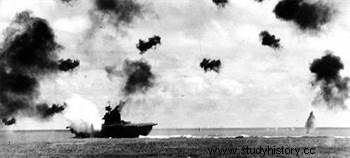 The Battle of Midway was a decisive naval air engagement of World War II, which gave the United States maritime supremacy over Japan in the Pacific Ocean. This battle took place from June 3 to 7, 1942 near the Midway Islands, northwest of the Hawaiian Islands. Foiling the Japanese strategy of establishing an underwater barrage around this atoll, the American army won a first significant victory over the Japanese, thus putting an end to the maritime expansion of the imperial army. By sinking 4 aircraft carriers, 3 destroyers, and 261 fighter planes, the hope of winning the war will change sides:Midway represents a turning point in the conflict in the same way as the victory of the Allies on the Russian front or in South Africa. North.
The Battle of Midway was a decisive naval air engagement of World War II, which gave the United States maritime supremacy over Japan in the Pacific Ocean. This battle took place from June 3 to 7, 1942 near the Midway Islands, northwest of the Hawaiian Islands. Foiling the Japanese strategy of establishing an underwater barrage around this atoll, the American army won a first significant victory over the Japanese, thus putting an end to the maritime expansion of the imperial army. By sinking 4 aircraft carriers, 3 destroyers, and 261 fighter planes, the hope of winning the war will change sides:Midway represents a turning point in the conflict in the same way as the victory of the Allies on the Russian front or in South Africa. North.
The Midway Trap
The paradoxical victory of the Battle of the Coral Sea in May 1942 gave hope to the Americans:after five months of defeats since Pearl Harbor, it seems that luck is turning. But Admiral Yamamoto has not said his last word, and he intends to lure enemy aircraft carriers into a trap... While the operation on Australia and New Guinea has been stopped in the Coral Sea , Admiral Yamamoto decides to keep the initiative by planning a new offensive. If the primary objective seems minor, the real goal is to attract the enemy fleet and destroy it.
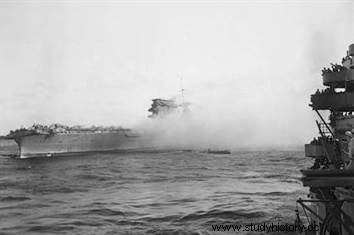 Indeed, it is Midway, an atoll in the middle of the Pacific, on which Yamamoto sets his sights; it is not of great strategic interest, being far from everything, but a landing there would still force the Americans to react. The Japanese admiral is counting on the fact that the American fleet being reduced since Pearl Harbor, but also following the loss of the Lexington in the Coral Sea, the enemy will be forced to throw their last forces into this battle.
Indeed, it is Midway, an atoll in the middle of the Pacific, on which Yamamoto sets his sights; it is not of great strategic interest, being far from everything, but a landing there would still force the Americans to react. The Japanese admiral is counting on the fact that the American fleet being reduced since Pearl Harbor, but also following the loss of the Lexington in the Coral Sea, the enemy will be forced to throw their last forces into this battle.
It is also decided to launch a parallel attack on the Aleutians:if the goal is to confuse the Americans, it also has the disadvantage of complicating the Japanese plan, and even to divide the forces for no real reason, a flaw in strategy that will be recurrent during the war among the Japanese.
American surprises
The American fleet emerges from the Battle of the Coral Sea with mixed feelings:admittedly, it has stopped the Japanese offensive on Australia, but it has also lost the port -Lexington aircraft , and the Yorktown is in a sorry state, which means that the US Navy is in a little more enviable situation than the day after Pearl Harbor!
Fortunately, Admiral Nimitz quickly receives first good news:the intelligence services have made great progress since Pearl Harbor, and it seems that they have identified the next target enemy by breaking the Japanese code:Midway! Chester Nimitz then orders the Yorktown to be repaired as soon as possible. (commanded by Fletcher) at Pearl Harbor, which is done in record time, while the aircraft carrier seemed to be in dry dock for several weeks...
Second good news, the Admiral can also count on Enterprise aircraft carriers and Hornet (ordered by Spruance), which should be able to be in the area quickly. The forces balance each other, but the Japanese ignore it.
Preludes to the Battle of Midway
Indeed, too focused on executing their difficult plan, the Japanese did not expect to have three aircraft carriers in front of them; they think Yorktown was sunk in the Coral Sea! Moreover, they must do without the Shokaku and Zuikaku , themselves damaged during this battle. Yamamoto therefore has "only" four aircraft carriers for the attack on Midway:the Kaga , the Hiryu , the Akagi and the Soryu . Note that all were present during the attack on Pearl Harbor...
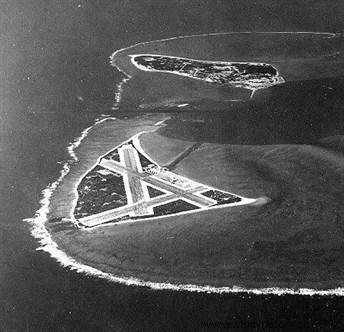
It was therefore a large part of the Japanese armada that left Japan on May 26, 1941, heading for both Midway and the Aleutians. The next day, the American task forces left the harbor of Pearl Harbor, without the enemy knowing about it; worse, the Japanese general staff believes the Enterprise and the Hornet still in the waters of the Solomons…The intelligence war has already been won by the Americans.
The first contact took place on June 3, precisely to the great surprise of the Japanese:they thought they were not expected, but they found themselves bombarded by B-25 come from Midway! The damage is minimal, except on Japanese morale, especially when it is proven that the Americans did not fall into the trap of the Aleutians, where the attack leads to nothing.Raid on Midway and reconnaissance
Obviously, Yamamoto won't stop his attack. He orders Nagumo to launch the raid on the atoll:it is June 4, 1942. At 7:10 a.m., the first assault is over, the Japanese pilots request a second; they cross the American air force of Midway which attacks the Japanese fleet without convincing results. It is not 9 a.m. that aviation based on the atoll no longer exists! Their sacrifice is not in vain, however:in the meantime, the Japanese have spotted the American fleet, but are unable to attack it because of the raid of these planes from Midway!
A few hours ago, in fact, the ballet of recognition devices began. Admiral Nagumo receives disturbing messages, sometimes confused, but one of which mentions the presence of an American aircraft carrier. He hesitates, but sure of his strength he finally does not launch an attack yet, waiting for the end of the raids on Midway. The confusion was such that the Japanese mechanics had to change the ammunition of the aircraft twice, replacing torpedoes with bombs, and vice versa. A problem encountered on the four Japanese aircraft carriers, the disorganization is therefore total. Nightmare for the Japanese:the Americans have also spotted them...
American cardboard
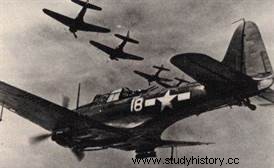
It is only 5 a.m. when an American reconnaissance aircraft spots the enemy fleet, well before the Japanese have reported Fletcher's aircraft carrier, the Yorktown . These are Enterprise devices. who are the first on the Japanese fleet, two hours after the start of the raid on Midway; but the old Devastator torpedo boats hardly get results and they are pulled like rabbits by the Japanese DCA. However, they have the merit of also diverting enemy fighters, which leaves room for subsequent aircraft, in particular the Dauntless dive bombers .
Then a deluge of bombs falls on Nagumo's fleet! Within minutes the Kaga , the Akagi and the Soryu are sunk or disabled! The planes present on the decks to change their bombs into torpedoes this time did not help things... At the end of the American raid which lasted twenty minutes, the Japanese fleet only had the aircraft carrier Hiryu capable of launching aircraft.
Farewell to Yorktown
The Devices of Hiryu launch in turn on the attack, at 10:40 a.m. Their target is the aircraft carrier spotted earlier in the day, the Yorktown . The hero of the Battle of the Coral Sea is hit by three bombs which seriously damage him; then a second wave and this time it was two torpedoes that hit him. There is no more hope and, worse, the aircraft carrier is finished off two days later by a submarine, which also manages to sink the destroyer which was escorting it! Meanwhile, the craft launched a new attack on Nagumo's fleet, sinking the Hiryu; revenge in remembrance of Yorktown continues with the two-day pursuit of heavy cruisers Mikuma and Mogami , the first being finally sunk, the second very badly damaged.
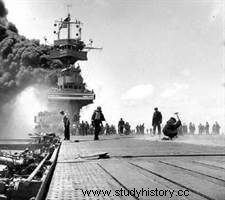
Admiral Yamamoto understood the tragedy too late and he cannot come to Nagumo's aid. He orders the retreat. Failure is painful.
Results and consequences of the Battle of Midway
This time, unlike the Battle of the Coral Sea, the results are not debatable! The Japanese left four aircraft carriers there, the Americans only one! Above all, the Japanese fleet has lost far too many of its most experienced pilots, which will be decisive for the rest of the war.
At the strategic level, Admiral Yamamoto fails in his capture of Midway but, more importantly, he has lost the initiative. From Midway, the Japanese advance is definitely stopped but, above all, the Americans can launch the counter-attack, which will begin with Guadalcanal. It was a turning point in the conflict in the Pacific, just like the victory of the Allies on the Russian front or in North Africa.
Finally, this naval battle establishes for good the domination of the aircraft carrier over the fleets, to the detriment of the battleship. Which will be symbolically recorded by the agony of the giants Musashi and Yamato later in the conflict. But we are not there yet...
Non-exhaustive bibliography
- J.J. Antier, The Great Naval Battles of World War II, Omnibus, 2000.
- P. Souty, The Pacific War 1937-1945, PUL, 1995.
- J. Costello, The Pacific War, 2 volumes, Pygmalion, 1982.
To go further
- The Battle of Midway, by Jack Smight, with Charlton Heston and Henry Fonda. Universal, 1976.
